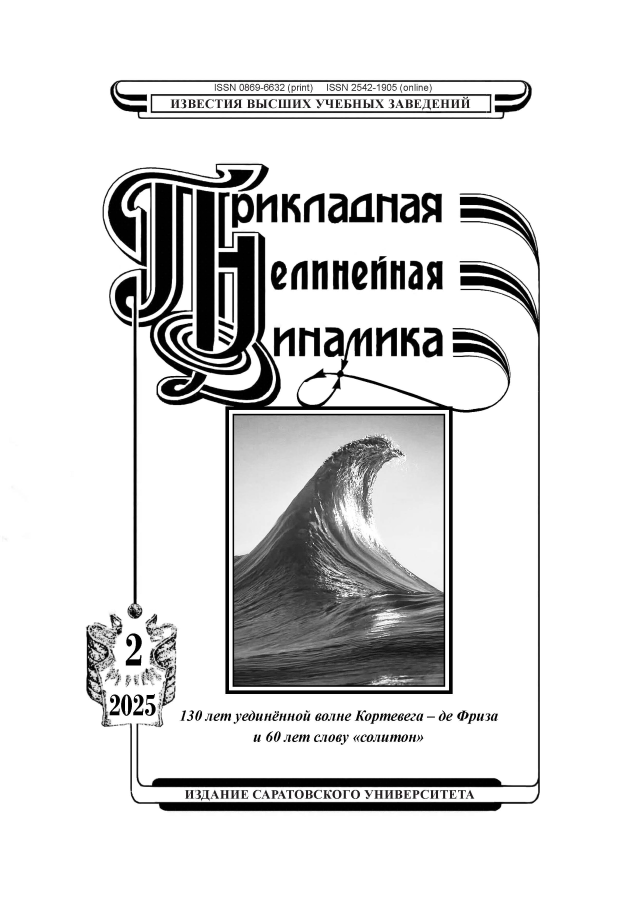Local dynamics of laser chain model with optoelectronic delayed unidirectional coupling
- Authors: Grigorieva E.V.1, Kashchenko S.A.2
-
Affiliations:
- Belarus State Economic University (BSEU)
- P. G. Demidov Yaroslavl State University
- Issue: Vol 30, No 2 (2022)
- Pages: 189-207
- Section: Articles
- URL: https://journal-vniispk.ru/0869-6632/article/view/252092
- DOI: https://doi.org/10.18500/0869-6632-2022-30-2-189-207
- ID: 252092
Cite item
Full Text
Abstract
Keywords
About the authors
Elena Viktorovna Grigorieva
Belarus State Economic University (BSEU)Republic of Belarus, 220070 Minsk, Partizansky Prospekt, 26
Sergej Aleksandrovich Kashchenko
P. G. Demidov Yaroslavl State University150000 Yaroslavl, Sovetskaya str., 14
References
- Pikovsky A., Rosenblum M., Kurths J. Synchronization: A Universal Concept in Nonlinear Sciences. Cambridge: Cambridge University Press, 2001. 411 p. doi: 10.1017/CBO9780511755743.
- Stankovski T., Pereira T., McClintock P. V. E., Stefanovska A. Coupling functions: Universal insights into dynamical interaction mechanisms // Rev. Mod. Phys. 2017. Vol. 89, no. 4. P. 045001. doi: 10.1103/RevModPhys.89.045001.
- Клиньшов В. В., Некоркин В. И. Синхронизация автоколебательных сетей с запаздывающими связями // УФН. 2013. Т. 183, № 12. С. 1323-1336. doi: 10.3367/UFNr.0183.201312c.1323.
- Kuramoto Y. Chemical Oscillations, Waves, and Turbulence. Berlin: Springer-Verlag, 1984. 158 p. doi: 10.1007/978-3-642-69689-3.
- Schuster H. G., Wagner P. Mutual entrainment of two limit cycle oscillators with time delayed coupling // Progress of Theoretical Physics. 1989. Vol. 81, no. 5. P. 939-945. doi: 10.1143/PTP.81.939.
- Perlikowski P., Yanchuk S., Popovych O. V., Tass P. A. Periodic patterns in a ring of delay-coupled oscillators // Phys. Rev. E. 2010. Vol. 82, no. 3. P. 036208. doi: 10.1103/PhysRevE.82.036208.
- Klinshov V., Shchapin D., Yanchuk S., Wolfrum M., D’Huys O., Nekorkin V. Embedding the dynamics of a single delay system into a feed-forward ring // Phys. Rev. E. 2017. Vol. 96, no. 4. P. 042217. doi: 10.1103/PhysRevE.96.042217.
- Dahms T., Lehnert J., Scholl E. Cluster and group synchronization in delay-coupled networks // Phys. Rev. E. 2012. Vol. 86, no. 1. P. 016202. doi: 10.1103/PhysRevE.86.016202.
- Ramana Reddy D. V., Sen A., Johnston G. L. Experimental evidence of time-delay induced death in coupled limit-cycle oscillators // Phys. Rev. Lett. 2000. Vol. 85, no. 16. P. 3381-3384. doi: 10.1103/PhysRevLett.85.3381.
- Soriano M. C., Garcia-Ojalvo J., Mirasso C. R., Fischer I. Complex photonics: Dynamics and applications of delay-coupled semiconductors lasers // Rev. Mod. Phys. 2013. Vol. 85, no. 1. P. 421-470. doi: 10.1103/RevModPhys.85.421.
- Hohl A., Gavrielides A., Erneux T., Kovanis V. Localized synchronization in two coupled nonidentical semiconductor lasers // Phys. Rev. Lett. 1997. Vol. 78, no. 25. P. 4745-4748. doi: 10.1103/PhysRevLett.78.4745.
- Wunsche H.-J., Bauer S., Kreissl J., Ushakov O., Korneyev N., Henneberger F., Wille E., Erzgraber H., Peil M., Elsaßer W., Fischer I. Synchronization of delay-coupled oscillators: A study of semiconductor lasers // Phys. Rev. Lett. 2005. Vol. 94, no. 16. P. 163901. doi: 10.1103/PhysRevLett.94.163901.
- Otten J., Muller J., Monnigmann M. Bifurcation-aware optimization and robust synchronization of coupled laser diodes // Phys. Rev. E. 2018. Vol. 98, no. 6. P. 062212. doi: 10.1103/PhysRevE.98.062212.
- Carra T. W., Taylor M. L., Schwartz I. B. Negative-coupling resonances in pump-coupled lasers // Physica D. 2006. Vol. 213, no. 2. P. 152-163. doi: 10.1016/j.physd.2005.10.015.
- Uchida A., Matsuura T., Kinugawa S., Yoshimori S. Synchronization of chaos in microchip lasers by using incoherent feedback // Phys. Rev. E. 2002. Vol. 65, no. 6. P. 066212. doi: 10.1103/PhysRevE.65.066212.
- Uchida A., Mizumura K., Yoshimori S. Chaotic dynamics and synchronization in microchip solid-state lasers with optoelectronic feedback // Phys. Rev. E. 2006. Vol. 74, no. 6. P. 066206. doi: 10.1103/PhysRevE.74.066206.
- Kim M.-Y., Roy R., Aron J. L., Carr T. W., Schwartz I. B. Scaling behavior of laser population dynamics with time-delayed coupling: Theory and experiment // Phys. Rev. Lett. 2005. Vol. 94, no. 8. P. 088101. doi: 10.1103/PhysRevLett.94.088101.
- Vicente R., Tang S., Mulet J., Mirasso C. R., Liu J.-M. Dynamics of semiconductor lasers with bidirectional optoelectronic coupling: Stability, route to chaos, and entrainment // Phys. Rev. E. 2004. Vol. 70, no. 4. P. 046216. doi: 10.1103/PhysRevE.70.046216.
- Vicente R., Tang S., Mulet J., Mirasso C. R., Liu J.-M. Synchronization properties of two self-oscillating semiconductor lasers subject to delayed optoelectronic mutual coupling // Phys. Rev. E. 2006. Vol. 73, no. 4. P. 047201. doi: 10.1103/PhysRevE.73.047201.
- Schwartz I. B., Shaw L. B. Isochronal synchronization of delay-coupled systems // Phys. Rev. E. 2007. Vol. 75, no. 4. P. 046207. doi: 10.1103/PhysRevE.75.046207.
- Perego A. M., Lamperti M. Collective excitability, synchronization, and array-enhanced coherence resonance in a population of lasers with a saturable absorber // Phys. Rev. A. 2016. Vol. 94, no. 3. P. 033839. doi: 10.1103/PhysRevA.94.033839.
- Кащенко С. А. О квазинормальных формах для параболических уравнений с малой диффузией // Доклады Академии наук СССР. 1988. Т. 299, № 5. С. 1049-1052.
- Kaschenko S. A. Normalization in the systems with small diffusion // International Journal of Bifurcation and Chaos. 1996. Vol. 6, no. 6. P. 1093-1109. doi: 10.1142/S021812749600059X.
- Кащенко С. А. Асимптотика пространственно-неоднородных структур в когерентных нелинейно-оптических системах // Журнал вычислительной математики и математической физики. 1991. Т. 31, № 3. С. 467-473.
- Grigorieva E. V., Haken H., Kaschenko S. A. Theory of quasiperiodicity in model of lasers with delayed optoelectronic feedback // Optics Communications. 1999. Vol. 165, no. 4-6. P. 279-292. doi: 10.1016/S0030-4018(99)00236-9.
- Kashchenko S. A. Dynamics of advectively coupled Van der Pol equations chain // Chaos. 2021. Vol. 31, no. 3. P. 033147. doi: 10.1063/5.0040689.
- Ханин Я. И. Основы динамики лазеров. М.: Наука, 1999. 368 с.
- Akhromeyeva T. S., Kurdyumov S. P., Malinetskii G. G., Samarskii A. A. Nonstationary dissipative structures and diffusion-induced chaos in nonlinear media // Phys. Rep. 1989. Vol. 176, no. 5-6. P. 189-370. doi: 10.1016/0370-1573(89)90001-X.
Supplementary files










